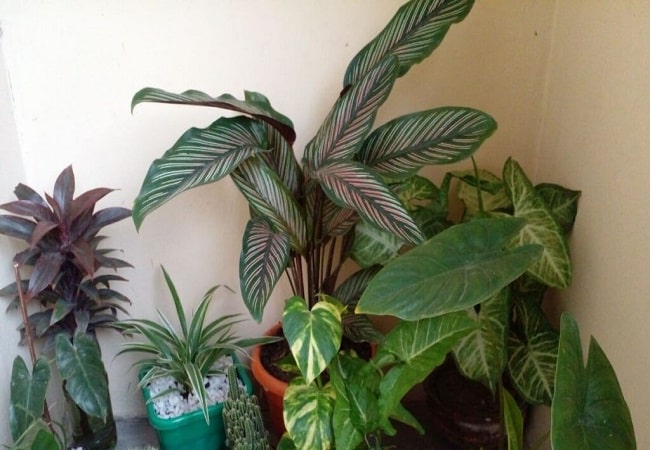Calathea plants are known for their striking, ornate foliage, making them a popular choice for indoor gardeners seeking to add a touch of the tropics to their living spaces. However, why are the edges of my calathea leaves turning brown? it can be disheartening to see the edges of your Calathea leaves turning brown, detracting from their beauty and potentially indicating an underlying issue.
In this article, we will explore the reasons behind brown leaf edges on your Calathea plant, examining factors such as humidity, water quality, and nutrient imbalances. By understanding the potential causes and addressing them effectively, you can help restore the lush vibrancy of your Calathea and keep it thriving for years to come.
Quick Navigation
The Most Common Causes For Your Calathea Leaves Edges Are Turning Brown
One of the most common things that go wrong with Calathea plants is that the edges of their leaves turn brown. Several potential factors are at play here,
Improper Water Quality
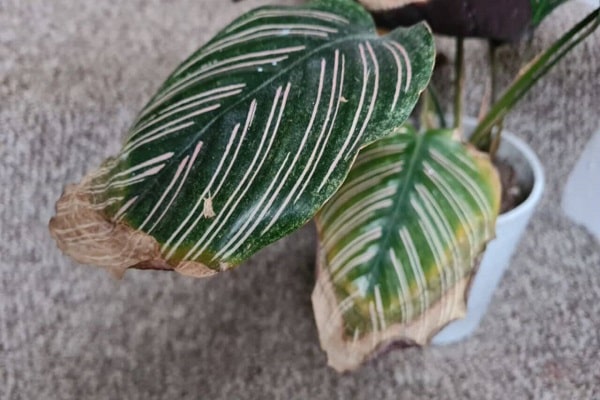
Using water with many dissolved minerals, chlorine, or fluoride is one of the main reasons Calathea leaves turn brown. When you change how much you water or how damp the air is, it’s easy to forget about this problem.
Calathea plants are sensitive to the minerals and chemicals often dissolved in drinking water and added to it. The best thing to do is to use rainwater or bottled water that has been distilled. This will stop the browning quickly if that is the problem.
If you water your calathea with tap water, the water probably has too many minerals and salts. When it comes to this, calatheas are very touchy. The leaves will get burned by salts, fluoride, chloride, and other chemicals.
Some homes may have fine water, but most have too heavy water for calatheas to be happy.
If the problem worsens, your calathea’s leaves will turn brown, curl up, and die.
Start watering your calathea with filtered, distilled, or rainwater to keep the leaves from turning brown.
Improper Fertilizer
Like many other houseplants, this one doesn’t need much fertilizer when it’s grown inside. The soil in the pot gives it most of what it needs.
If you use fertilizer on a Calathea plant, the extra minerals and nutrients in the soil may “burn” the leaf tips, making them turn brown. It’s the same problem as water with many chlorine or dissolved minerals. Avoid fertilizing and change the potting soil if you’ve already given the plant a heavy dose.
If you give your plant too much food, minerals and salts will build up in the soil, which will soon be visible on the leaves.
This can also happen if you water the plant from the bottom and don’t fertilize it too much. Even though watering from the bottom is good for many plants and can keep them from getting too much water, it doesn’t get rid of the salts and minerals that build up in the soil. If your water is from the bottom, it’s a good idea to occasionally water from the top and let the water run through the soil. This will help get rid of extra minerals and salts.
If you think the problem is too much food, flush the soil by letting the water run through it for a while. Don’t use fertilizers.
Wrong Light Conditions

When calathea leaves start to turn brown and fall off the plant, it is often due to the plant being in the wrong light conditions. The leaves are not getting the proper amount of light, so they start to die. When this happens, the pigment in the leaves starts to break down, and they turn brown. You can remedy this by moving the plant into a brighter area or adding artificial lighting to help it get enough light.
Low Humidity
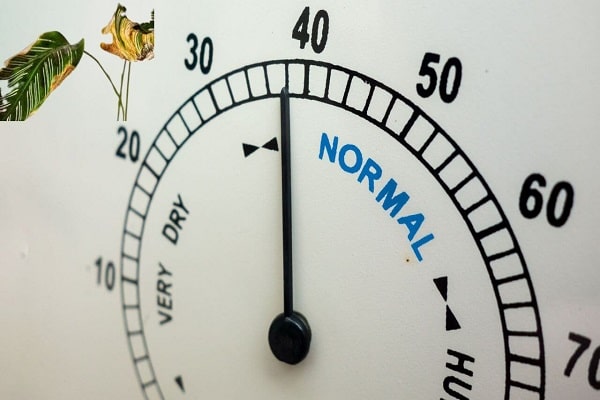
The leaves of a calathea plant may turn brown and die due to low humidity levels. The leaves will not turn brown and remain healthy in areas with high humidity levels. When the humidity level drops, the leaves are more likely to turn brown because they do not have enough water to stay alive. If the humidity levels remain low, the leaves will eventually die.
Calatheas need a lot of moisture, ideally more than 50%, but some types of calathea need a lot more. The more fragile a plant is, the more likely it is to have brown tips. If you have more than one type, you will see that some do well, and others don’t.
Reduced Temperature
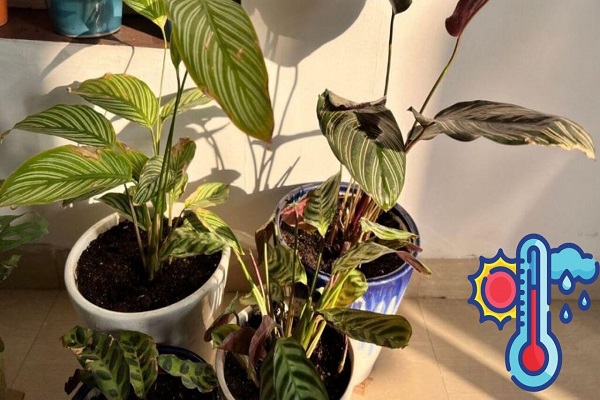
Temperature is a crucial factor in the health of plants. Too high or too low temperatures can cause damage to the plant’s tissues, leading to leaf browning and other symptoms.
The leaves of some plants may turn brown and die due to a temperature decline. This is most commonly seen with calathea plants, which are often grown as indoor plants due to their attractiveness and easy care.
Lowering the temperature of these plants can help prevent leaf browning and keep them healthy. If you’re growing calathea indoors, keep an eye on the temperature, so it remains within the appropriate range.
Calatheas like temperatures between 65°F and 85°F (18°C and 30°C), which is similar to their native habitat in the tropics. Keep temperatures above 15 degrees Celsius (60 degrees Fahrenheit) to prevent frost damage.
Poor Drainage

Another possible cause of leaf browning in calathea plants is poor drainage. If the soil is too wet or there are restrictions in the plant’s root system, water can’t flow away quickly enough, causing it to accumulate on the leaves.
You can correct poor drainage by adding gravel, sand, or other porous material to the soil around the plant. This will help to increase airflow and reduce moisture buildup on the leaves.
Pest And Diseases
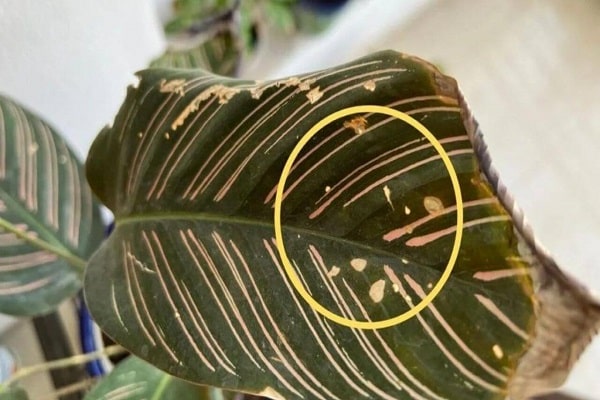
There are many reasons why the edges of a calathea’s leaves may turn brown, such as from pests and diseases. One common pest is aphids, which can cause spotting or distortion on the leaves and stunt growth.
Additionally, calathea often suffers from fungal infections, including whitefly and spider mites. Diseases can also ravage the plant and cause browning at the edges of the leaves. While there is no one answer to why particular plants may turn brown in certain areas, knowing the possible causes will help you to address them promptly.
Age Of The Plant
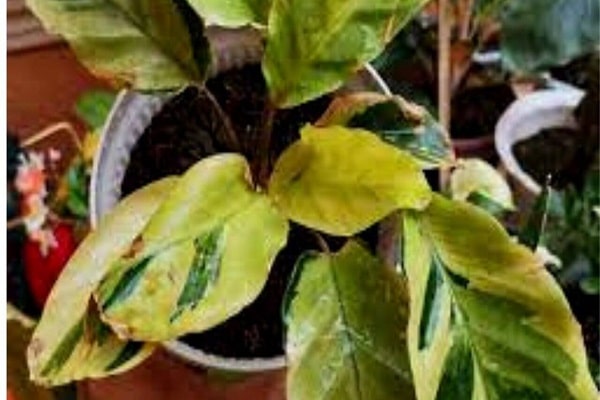
As a leaf gets old and loses its strength, it will turn brown to some degree. Every leaf on a Calathea plant will get old and die at some point, so it needs to grow new leaves often to stay healthy.
Don’t worry if a few older leaves turn yellow and brown over time. That’s just how this plant grows. The browning of a few tips on newer growth is a better sign of problems with cultivation.
5 Tips To Keep Your Calathea Leaves From Developing Browning

A few things can cause the edges of your Calathea leaves to turn brown and lose their luster. Here are five tips to help prevent this from happening:
- Make sure that you are providing enough water to your plants. Over-watering can lead to plant stress, which can cause browning.
- Avoid fertilizing your plants too heavily; over-fertilization can also lead to browning. Fertilize them only when necessary, and ensure the fertilizer you use is specifically for succulents.
- Avoid exposing your plants to direct sunlight; this will help keep them from becoming overly dry and causing browning on the edges of their leaves.
- Keep an eye on your plants in the fall and winter, as cold temperatures can lead to leaf drops and browning on the edges of leaves due to freezing damage.
- Prune off any diseased or damaged leaves as soon as you notice them; doing so will help reduce stress on the plant and reduce the chance of browning.
Frequently Asked Questions
Should I Cut Brown Tips Off Calathea?
In general, it is advisable to cut off brown tips from calathea plants to avoid the possibility of pests and diseases. However, there are a few exceptions to this rule. If the brown tips are necessary for the growth or health of the plant, then you should not remove them. Additionally, suppose a calathea has been grown in a container or pot. In that case, you may retain the brown tips as they will help prevent soil erosion.
Should I Cut Off Crispy Calathea Leaves?
There are several potential benefits and drawbacks to cutting calathea leaves.
- One potential benefit is that the leaves will be less likely to attract insects and other contaminants.
- Another potential benefit is that the leaves will be less likely to wilt and die. However, there are also several potential drawbacks to cutting calathea leaves.
- One drawback is that the leaves may become less crispy.
- Another possible drawback is that the nutrients in the leaves may be lost.
Why Is My Calathea Curling And Crispy?
There are a few reasons why your Calathea may be curling and crispy.
- Firstly, if it is getting too dry, the leaves may curl and become crispy because they will not be able to uptake water or nutrients from the soil.
- Secondly, suppose the plant is fertilized improperly. In that case, there may be an overabundance of nitrogen, leading to the leaves becoming crispy.
- Lastly, the leaves may become crispy if the plant receives too much direct sunlight.
Why Do Calatheas Close At Night?
The leaves of the calathea, a common houseplant, close at night to conserve energy. This adaptive response allows the plant to save energy for when it is most needed, such as during periods of low light.
Why Did My Calathea Stop Moving?
Calathea is often used as houseplants because of their relatively fast growth rate, making them appear thriving even when they’re not. However, suppose a calathea’s soil is too dry or too sandy. In that case, the plant may struggle to absorb water and nutrients and eventually stop moving. In cases like this, you may need to water your calathea more frequently or add more nutrients to its soil.
Final Touch
The brown edges on your calathea leaves may signify nutrient deficiencies, most likely caused by a lack of iron and magnesium. To avoid these deficiencies, make sure to provide your plants with the appropriate amounts of these nutrients.
If you need more specific advice on how to care for your calathea plants, visit our link: https://clubgardening.com/calathea-white-star-care-guide/

My name is Md Deloar Hossain and I’m the creator of Club Gardening, designed for all your gardening ideas, gardening product reviews, and a place to help you find the best gardening experience possible.

